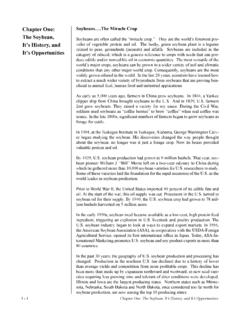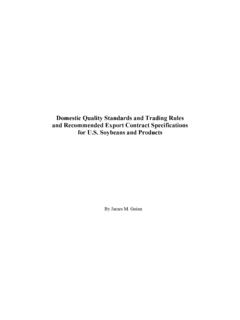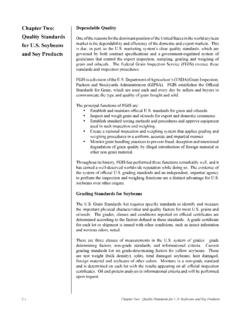Transcription of Biosecurity Guide for Commercial Poultry Production in …
1 Biosecurity Guide for CommercialPoultry Production in theMiddle East and North AfricaINDEXI ntroduction 5 Importance of Biosecurity 6 Definition and basic principles of Biosecurity 8 Portals of entry of disease agents 9 Location, house design and construction materials for bio secured Poultry farms 10 Movement control of vehicles, people and pests to prevent 13disease transmission among farmsImportance of chick quality 17 Importance of feed and water quality 18 Decontamination: cleaning, disinfection, down time and monitoring 19 Egg management: collection, disinfection and storage 26 Management of Poultry mortality 27 Disease prevention and monitoring during Production cycle 27 Commitment to Biosecurity efforts 29 Biosecurity and continuing education 29 Examples of poor Biosecurity 30 Glossary 34 International customers are vital to the success of the soy industry with over 60% of soybean Production exported in the last year making soy products the #1 agricultural export.
2 The soy industry appreciates the partnership with you and your local industries and customers. Our goal is to provide international customers with sustainable soy extending a performance advantage, delivery confidence, and a long term commitment to your markets and industries. We hope you find this manual helpful to your business and look forward to continuing our partnership to support the growth of the Poultry and soy industry in the Middle East and North BabbRegional Director Europe & Middle East/North Soybean Export CouncilBiosecurity Guide for Commercial Poultry Production in theMiddle East and North Africa4 INTRODUCTIONOver the past 20 years, the Commercial Poultry industry has grown tremendously worldwide. Chicken consumption has increased due to its versatility as a food, and it is lower priced and considered a healthier choice as compared to other meats. As the Poultry industry has rapidly expanded, diseases have become more common and costly.
3 In many regions of the world, diseases in the Commercial Poultry industry are resulting in devastating losses. Companies have to rely on more vaccines and antibiotics to control losses. In recent years, several diseases including a variant Newcastle disease and several types of Avian Influenza have become endemic and are resulting in substantial loses. In the Middle East and North Africa, the Poultry industry is plagued with many diseases and these are having a negative impact on performance and profitability. As the Poultry industry expanded, there was little thought put into potential impacts of diseases. As a result, Poultry farms were located and designed without regard to disease control. The Poultry industry has attempted to limit losses due to disease. However, it is becoming apparent that it is necessary to go back to the basics . Many realize that vaccines and other treatments have limitations. To be successful, there has to be a change in the manner in which Poultry is raised.
4 The key to future success and expansion will come about through elimination and control of diseases and this can only be brought about by implementation of Biosecurity visiting the Poultry industry throughout the world, it is possible to visit countries and regions where Poultry diseases have been eliminated and there is little need for vaccines and treatments. In these areas, the efficiency of Production is excellent. These successful areas have incorporated stringent Biosecurity programs into their industries. Biosecurity has become part of the culture of raising at the United Soybean Export Council decided to prepare this manual to give farmers the information they need to implement a successful Biosecurity program. This program will enable farmers to control and eliminate diseases that are currently devastating the Poultry industry. The success of the Poultry industry depends on improved performance. This will allow the industry to continue to grow and increase demand for Guide for Commercial Poultry Production in theMiddle East and North AfricaIMPORTANCE OF Biosecurity In Commercial Poultry farms, the risk for disease outbreaks is high and can result in significant economic loss for the farmer and the integration.
5 When major disease outbreaks occur in a region, this may also result in loss of employment. A Newcastle or Influenza outbreak in an area involving numerous farms in close proximity can be catastrophic. Modern strains of Commercial broilers and layers have the genetic potential for high levels of Production of meat and eggs. However, modern chickens are more susceptible to disease and management problems than chickens in past years. As a result, the introduction of a disease into a flock results in much higher morbidity and Tunisia, despite modernization, improved management practices and development of an integrated Poultry industry during the past 30 years, the industry has suffered severe disease challenges in recent years. The general health of the nation s Poultry flocks has deteriorated following the introduction and spread of several diseases. There is much discussion over the recent introductions of these diseases and their rapid spread throughout the country.
6 For example, Newcastle disease of Genotype 7 entered the country and rapidly spread. This is resulting in substantial losses and vaccine efforts alone are doing little to control or eliminate the problem. It is suspected that these disease introductions were due to unregulated and unauthorized Poultry farms that do not comply with the basic standards of management and disease control. As well, illegal imports of hatching eggs and chicks from neighboring countries, where these diseases have been endemic, and the uncontrolled movement of Poultry and Poultry products within the country are also Poultry industry has expanded considerably so that the density of Poultry and farms in some regions is very high. Thus, it is necessary to implement strict sanitary and hygienic measures to prevent the introduction and spread of avian is critical to the future of the Poultry industry. While there are vaccines and antibiotics to assist, it will be necessary to prevent and eliminate disease agents if the Poultry industry is to prosper.
7 Biosecurity will determine the success or failure of the industry in the region. Thus, it must be fully understood and strictly implemented. Biosecurity is simply a plan to prevent the entry of a disease agent onto a farm and spread among farms. Mostly this is common sense, but a basic understanding of how diseases enter a farm, persist Biosecurity Guide for Commercial Poultry Production in theMiddle East and North Africa6in farm and are disseminated needs to be understood so control can be approached scientifically. Biosecurity must be approached from a country wide perspective to be truly WHOM IS THIS Guide INTENDED?This Guide was developed as a practical tool intended for those working directly with the Commercial Poultry industry; including Poultry farmers, technicians and other stakeholders in the Poultry farming sector. The objective was to provide a practical plan on how to establish a barrier to prevent entry of disease onto a farm. It is hoped that the simple recommendations provided will be studied and implemented throughout the region.
8 It cannot be denied that in areas where Biosecurity is an integral part of daily operations, disease challenge is much lower; and when rare challenges occur, the diseases are quickly Guide was produced by the Interprofessional Association of Poultry and Rabbit Products (Groupement Interprofessional de Produits Avicoles et Cunicoles, GIPAC), with the assistance of the United Nations Food and Agricultural Organization (FAO) and the valuable contribution by Dr. Khaled Kaboudi, the veterinary specialist in Poultry and avian pathology. He is an assistant professor at the University Hospital of the National School of Veterinary Medicine of Sidi Thabet. This Guide was translated from Arabic to English by Dr. Kamel special thanks to the editorial team and everyone else who contributed to the development of this practical Editorial Board7 Biosecurity Guide for Commercial Poultry Production in theMiddle East and North AfricaDEFINITION AND BASIC PRINCIPLES OF BIOSECURITYB iosecurity simply means what do we have to do to keep diseases from entering a Poultry farm.
9 Biosecurity has been defined as informed common sense . This means that the basic principles of Biosecurity are learned and this is combined with common sense husbandry practices . There is nothing complex about Biosecurity . As most people learn about Biosecurity they often state that I knew that . Once it is understood how diseases spread, then practices at a farm need to be modified. There are many myths and misconceptions about disease spread. A strategic and scientific approach has consistently been shown to be effective. Many experienced Poultry farmers concur that if you have a comprehensive Biosecurity program in practice, you may not eliminate the possibility of a disease outbreak, but the probability is greatly reduced for a farm or is based on 2 fundamental principles (Figure 1):. 1 Preventing the introduction of a disease agent onto a farm- referred to as bio-exclusion .. 2 Preventing the spread of a disease agent on a farm- referred to as bio-confinement.
10 Bio-ConfinementBirds HealthManagementOperationsManagementBio- ExclusionAccessHealthManagementFigure 1: Principles of biosecurityBiosecurity Guide for Commercial Poultry Production in theMiddle East and North Africa8 AnimalsWater NetworkChicksPeopleNeighbouring farmsWild birdsVehiclePoultry equipmentsFigure 2: Sources of contamination on Poultry farmsPORTALS OF ENTRY OF DISEASE AGENTST here are many ways in which disease agents may gain entry into a farm (Figure 2). Disease agents can enter a farm on living (biological) and nonliving (fomites) carriers. It is important that the most significant means of transmission be understood so that efforts at Biosecurity can be prioritized on the highest risk factors. It is well documented that the vast majority of diseases are carried onto a farm by contaminated people, equipment and vehicles. It has been stated that likely over 80% of diseases are brought onto the farm by these means. Thus, attention needs to be focused on these factors.










